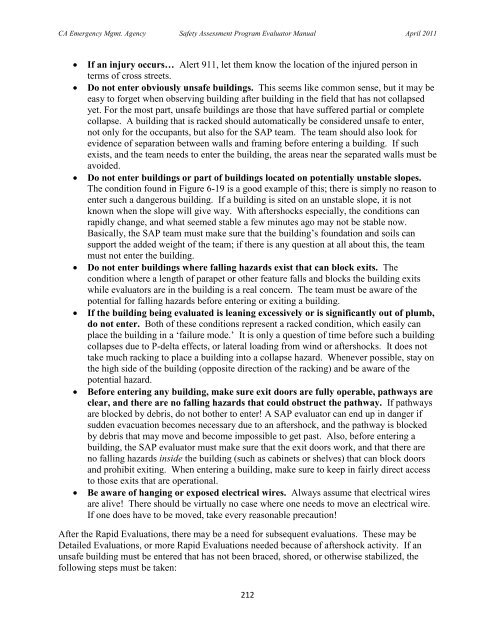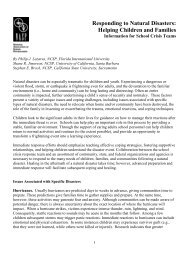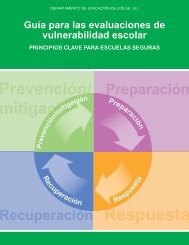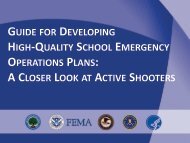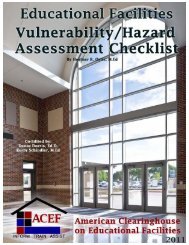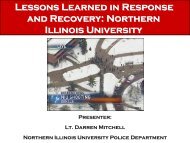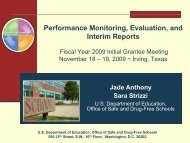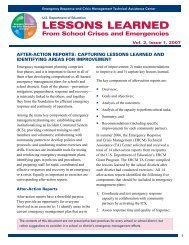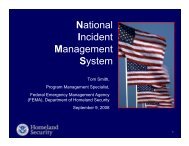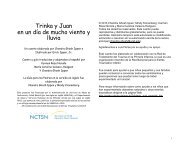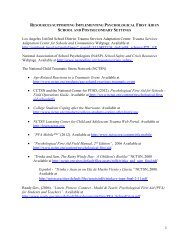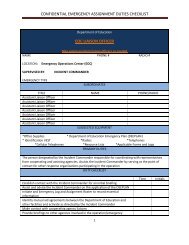Safety Assessment Program Evaluator Student Manual
Safety Assessment Program Evaluator Student Manual
Safety Assessment Program Evaluator Student Manual
Create successful ePaper yourself
Turn your PDF publications into a flip-book with our unique Google optimized e-Paper software.
CA Emergency Mgmt. Agency <strong>Safety</strong> <strong>Assessment</strong> <strong>Program</strong> <strong>Evaluator</strong> <strong>Manual</strong> April 2011If an injury occurs… Alert 911, let them know the location of the injured person interms of cross streets.Do not enter obviously unsafe buildings. This seems like common sense, but it may beeasy to forget when observing building after building in the field that has not collapsedyet. For the most part, unsafe buildings are those that have suffered partial or completecollapse. A building that is racked should automatically be considered unsafe to enter,not only for the occupants, but also for the SAP team. The team should also look forevidence of separation between walls and framing before entering a building. If suchexists, and the team needs to enter the building, the areas near the separated walls must beavoided.Do not enter buildings or part of buildings located on potentially unstable slopes.The condition found in Figure 6-19 is a good example of this; there is simply no reason toenter such a dangerous building. If a building is sited on an unstable slope, it is notknown when the slope will give way. With aftershocks especially, the conditions canrapidly change, and what seemed stable a few minutes ago may not be stable now.Basically, the SAP team must make sure that the building‟s foundation and soils cansupport the added weight of the team; if there is any question at all about this, the teammust not enter the building.Do not enter buildings where falling hazards exist that can block exits. Thecondition where a length of parapet or other feature falls and blocks the building exitswhile evaluators are in the building is a real concern. The team must be aware of thepotential for falling hazards before entering or exiting a building.If the building being evaluated is leaning excessively or is significantly out of plumb,do not enter. Both of these conditions represent a racked condition, which easily canplace the building in a „failure mode.‟ It is only a question of time before such a buildingcollapses due to P-delta effects, or lateral loading from wind or aftershocks. It does nottake much racking to place a building into a collapse hazard. Whenever possible, stay onthe high side of the building (opposite direction of the racking) and be aware of thepotential hazard.Before entering any building, make sure exit doors are fully operable, pathways areclear, and there are no falling hazards that could obstruct the pathway. If pathwaysare blocked by debris, do not bother to enter! A SAP evaluator can end up in danger ifsudden evacuation becomes necessary due to an aftershock, and the pathway is blockedby debris that may move and become impossible to get past. Also, before entering abuilding, the SAP evaluator must make sure that the exit doors work, and that there areno falling hazards inside the building (such as cabinets or shelves) that can block doorsand prohibit exiting. When entering a building, make sure to keep in fairly direct accessto those exits that are operational.Be aware of hanging or exposed electrical wires. Always assume that electrical wiresare alive! There should be virtually no case where one needs to move an electrical wire.If one does have to be moved, take every reasonable precaution!After the Rapid Evaluations, there may be a need for subsequent evaluations. These may beDetailed Evaluations, or more Rapid Evaluations needed because of aftershock activity. If anunsafe building must be entered that has not been braced, shored, or otherwise stabilized, thefollowing steps must be taken:212


